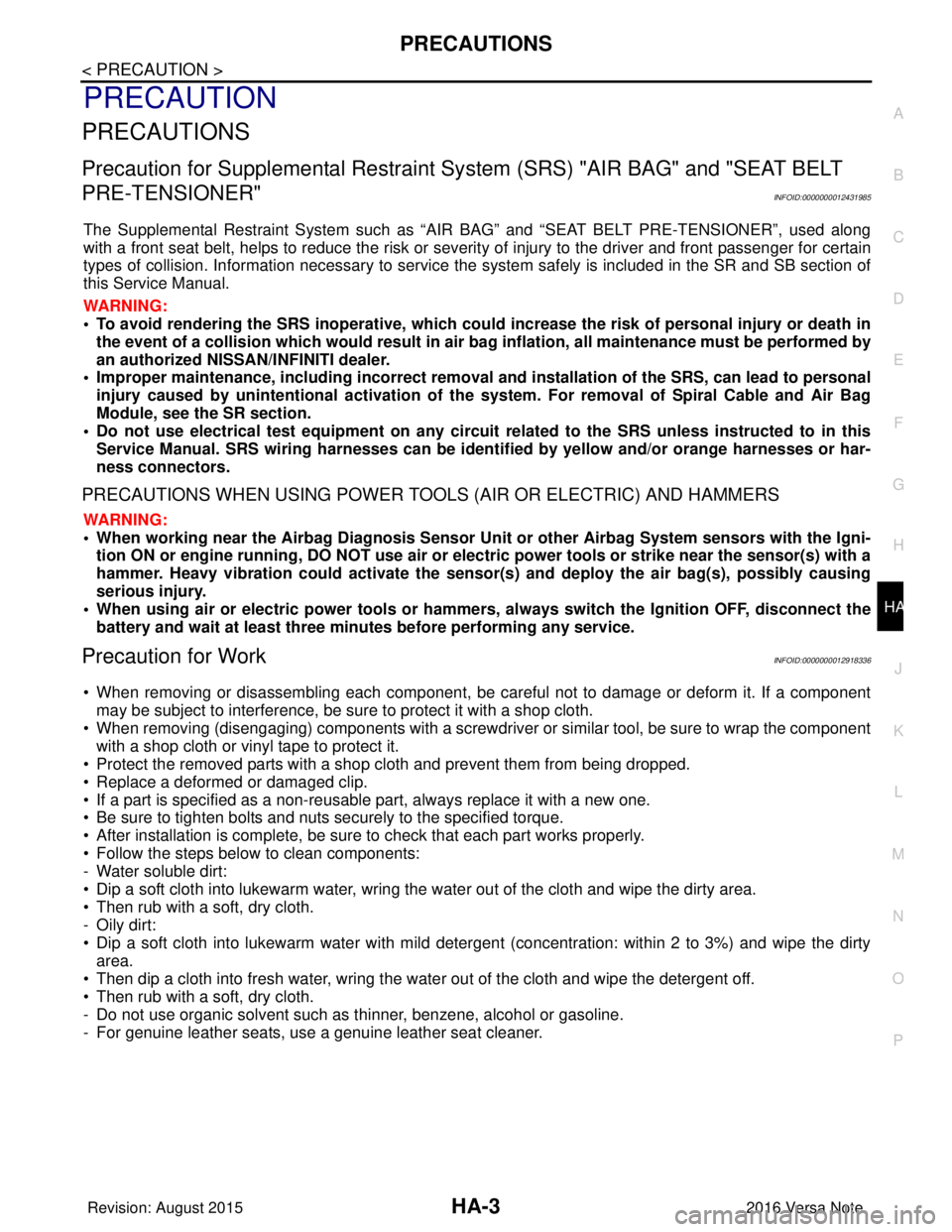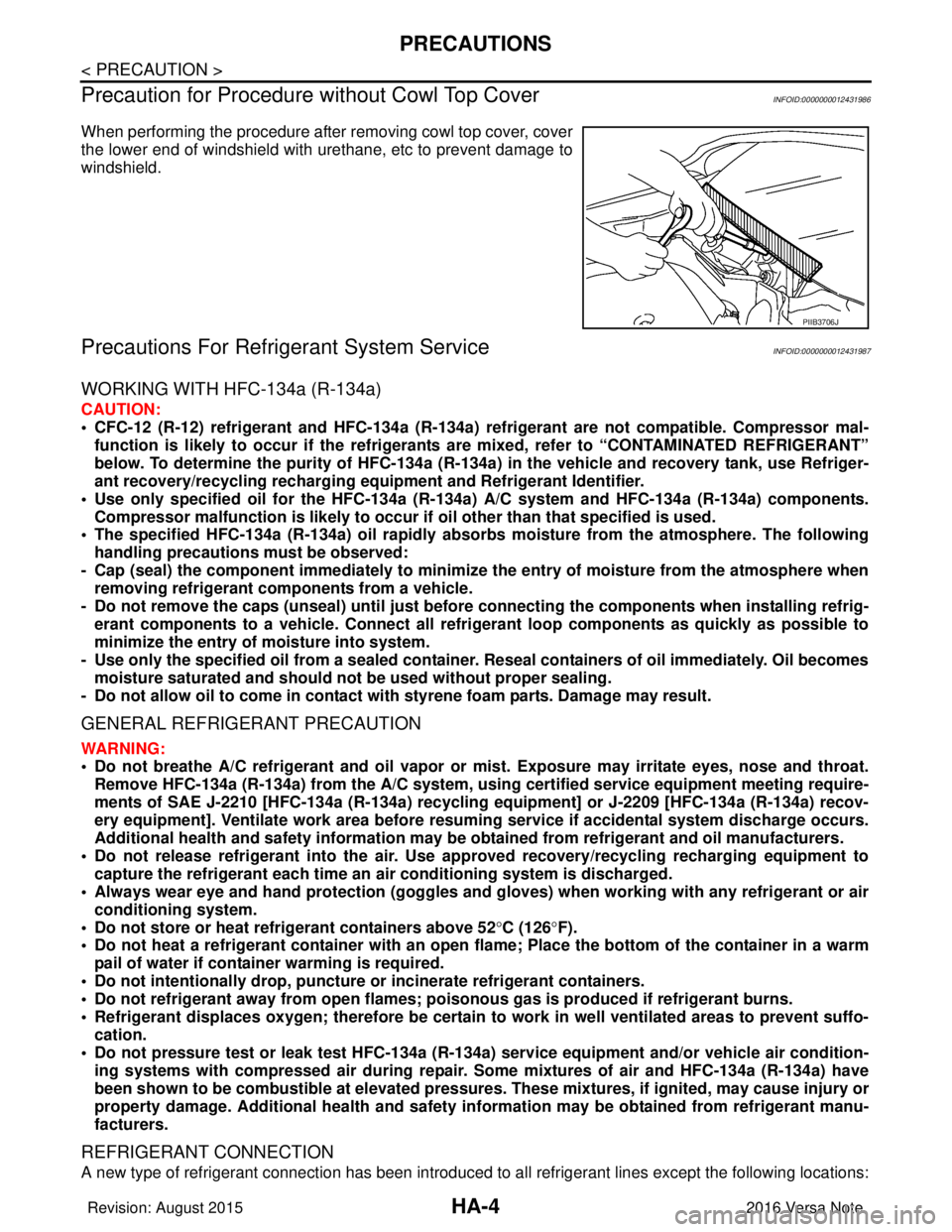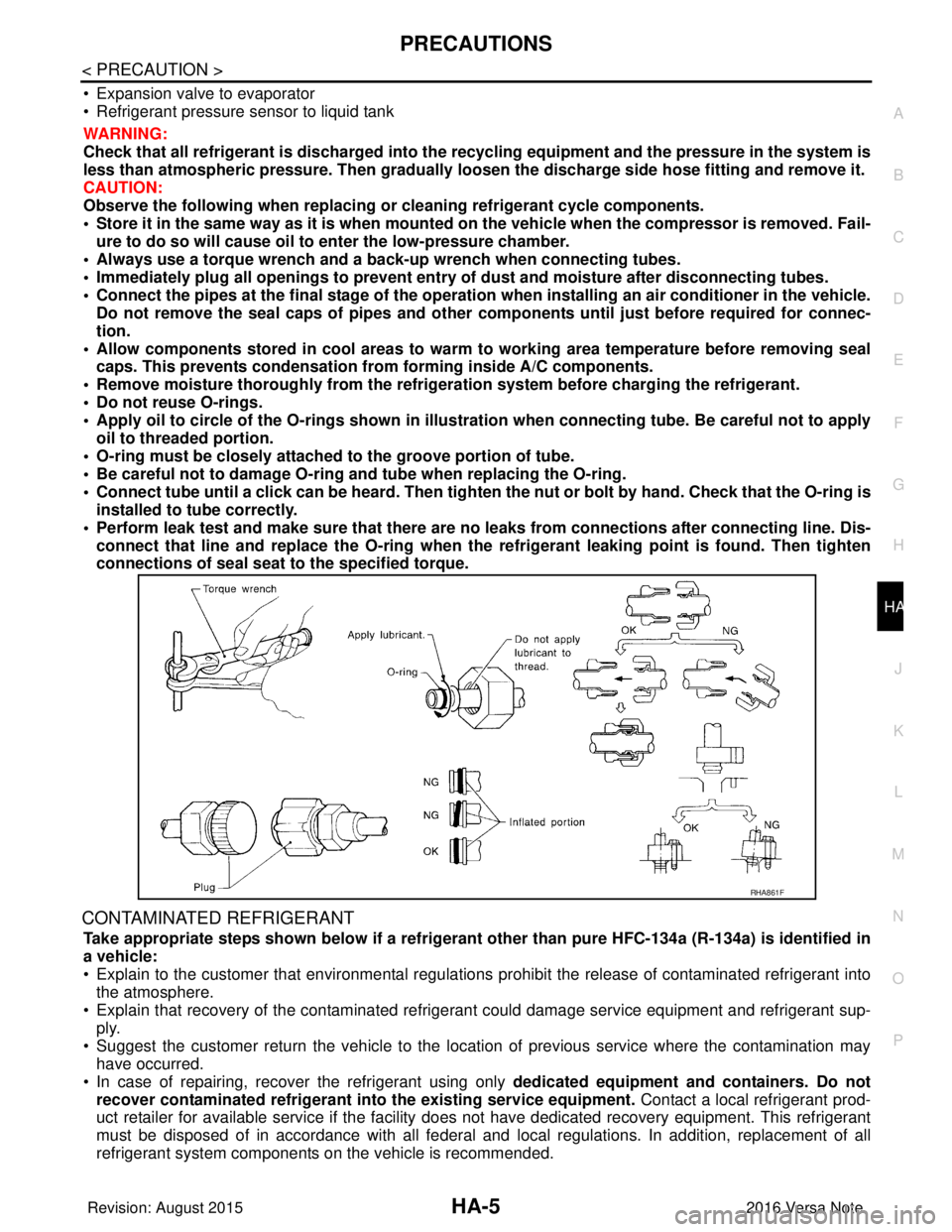NISSAN NOTE 2016 Service Repair Manual
Manufacturer: NISSAN, Model Year: 2016, Model line: NOTE, Model: NISSAN NOTE 2016Pages: 3641, PDF Size: 28.72 MB
Page 2021 of 3641
![NISSAN NOTE 2016 Service Repair Manual THERMO CONTROL AMPLIFIERHAC-53
< REMOVAL AND INSTALLATION > [MANUAL AIR CONDITIONING]
C
D
E
F
G H
J
K L
M A
B
HAC
N
O P
THERMO CONTROL AMPLIFIER
Removal and InstallationINFOID:0000000012430758
REMOVAL NISSAN NOTE 2016 Service Repair Manual THERMO CONTROL AMPLIFIERHAC-53
< REMOVAL AND INSTALLATION > [MANUAL AIR CONDITIONING]
C
D
E
F
G H
J
K L
M A
B
HAC
N
O P
THERMO CONTROL AMPLIFIER
Removal and InstallationINFOID:0000000012430758
REMOVAL](/img/5/57363/w960_57363-2020.png)
THERMO CONTROL AMPLIFIERHAC-53
< REMOVAL AND INSTALLATION > [MANUAL AIR CONDITIONING]
C
D
E
F
G H
J
K L
M A
B
HAC
N
O P
THERMO CONTROL AMPLIFIER
Removal and InstallationINFOID:0000000012430758
REMOVAL
1. Remove evaporator. Refer to HA-35, "EVAPORATOR : Removal
and Installation".
2. Remove thermo control amplifier (1) from evaporator (2).
INSTALLATION
Installation is in the reverse order of removal.
CAUTION:
• Do not reuse O-rings.
• Apply A/C oil to new O-ring for installation.
• After charging refrigerant, check for leaks. Refer to HA-18, "
Leak Test".
ALIIA0921ZZ
Revision: August 2015 2016 Versa Note
cardiagn.com
Page 2022 of 3641
![NISSAN NOTE 2016 Service Repair Manual HAC-54
< REMOVAL AND INSTALLATION >[MANUAL AIR CONDITIONING]
REFRIGERANT PRESSURE SENSOR
REFRIGERANT PRESSURE SENSOR
Removal and InstallationINFOID:0000000012430759
CAUTION:
Perform lubricant return o NISSAN NOTE 2016 Service Repair Manual HAC-54
< REMOVAL AND INSTALLATION >[MANUAL AIR CONDITIONING]
REFRIGERANT PRESSURE SENSOR
REFRIGERANT PRESSURE SENSOR
Removal and InstallationINFOID:0000000012430759
CAUTION:
Perform lubricant return o](/img/5/57363/w960_57363-2021.png)
HAC-54
< REMOVAL AND INSTALLATION >[MANUAL AIR CONDITIONING]
REFRIGERANT PRESSURE SENSOR
REFRIGERANT PRESSURE SENSOR
Removal and InstallationINFOID:0000000012430759
CAUTION:
Perform lubricant return operation before each A/C system disassembly. However, if a large amount of
refrigerant or lubricant leaks from the system, do no
t perform lubricant return operation. Refer to HA-
22, "Perform Oil Return Operation".
REMOVAL
1. Discharge the refrigerant. Refer to HA-20, "Recycle Refrigerant".
2. Remove front grille. Refer to EXT-32, "
Removal and Installation".
3. Remove upper air guide and air guide (LH). Refer to DLK-144, "
Exploded View".
4. Clean refrigerant pressure sensor and surrounding area. CAUTION:
Make sure to clean carefully.
5. Disconnect refrigerant pressure sensor harness connector.
6. Support liquid tank, then remove refrigerant pressure sensor (1). CAUTION:
• Be careful not to damage liquid tank.
• Be careful not to damage core surface of condenser.
• Cap or wrap the joint of the condenser and liquid tankwith suitable material such as vinyl tape to avoid the entry
of air.
INSTALLATION
Installation is in the reverse order of removal.
CAUTION:
• Do not reuse O-rings.
• Apply compressor oil to new O-ring of the refrigerant pressure sensor for installation.
• After charging refrigerant, check for leaks. Refer to HA-18, "
Leak Test".
ALIIA0004ZZ
Revision: August 2015 2016 Versa Note
cardiagn.com
Page 2023 of 3641
![NISSAN NOTE 2016 Service Repair Manual FRONT BLOWER MOTOR RESISTORHAC-55
< REMOVAL AND INSTALLATION > [MANUAL AIR CONDITIONING]
C
D
E
F
G H
J
K L
M A
B
HAC
N
O P
FRONT BLOWER MOTOR RESISTOR
Exploded ViewINFOID:0000000012430760
Removal and NISSAN NOTE 2016 Service Repair Manual FRONT BLOWER MOTOR RESISTORHAC-55
< REMOVAL AND INSTALLATION > [MANUAL AIR CONDITIONING]
C
D
E
F
G H
J
K L
M A
B
HAC
N
O P
FRONT BLOWER MOTOR RESISTOR
Exploded ViewINFOID:0000000012430760
Removal and](/img/5/57363/w960_57363-2022.png)
FRONT BLOWER MOTOR RESISTORHAC-55
< REMOVAL AND INSTALLATION > [MANUAL AIR CONDITIONING]
C
D
E
F
G H
J
K L
M A
B
HAC
N
O P
FRONT BLOWER MOTOR RESISTOR
Exploded ViewINFOID:0000000012430760
Removal and InstallationINFOID:0000000012430761
REMOVAL
1. From under the LH side of the instrment panel, disconnect harness connector from front blower motor
resistor.
2. Remove screws and front blower motor resistor.
INSTALLATION
Installation is in the reverse order of removal.
1. Heating and cooling unit assembly 2. Front blower motor 3. Front blower motor resistor
AWIIA1465ZZ
Revision: August 2015 2016 Versa Note
cardiagn.com
Page 2024 of 3641
![NISSAN NOTE 2016 Service Repair Manual HAC-56
< REMOVAL AND INSTALLATION >[MANUAL AIR CONDITIONING]
DOOR CABLE
DOOR CABLE
Exploded ViewINFOID:0000000012430762
INTAKE DOOR CABLE
INTAKE DOOR CABLE : Removal and InstallationINFOID:00000000124 NISSAN NOTE 2016 Service Repair Manual HAC-56
< REMOVAL AND INSTALLATION >[MANUAL AIR CONDITIONING]
DOOR CABLE
DOOR CABLE
Exploded ViewINFOID:0000000012430762
INTAKE DOOR CABLE
INTAKE DOOR CABLE : Removal and InstallationINFOID:00000000124](/img/5/57363/w960_57363-2023.png)
HAC-56
< REMOVAL AND INSTALLATION >[MANUAL AIR CONDITIONING]
DOOR CABLE
DOOR CABLE
Exploded ViewINFOID:0000000012430762
INTAKE DOOR CABLE
INTAKE DOOR CABLE : Removal and InstallationINFOID:0000000012430763
The intake door cable is not serviced separately. Refer to
HAC-52, "Removal and Installation".
INTAKE DOOR CABLE : AdjustmentINFOID:0000000012430764
1. Remove glove box assembly. Refer to IP-25, "Removal and Installation".
2. Disconnect intake door cable (1) from clip (A).
3. Set intake door lever to REC position.
4. Push intake door link (2) in the direction shown, then carefully pull outer cable to front air control side and connect clip.
1. Heating and cooling unit assembly 2. Plate 3. Air mix door linkage 2
4. Air mix door linkage 1 5. Air mix door cable6. Intake door lever
7. Intake door linkage 8. Intake door cable9. Foot door lever
10. Mode door cable 11. Main linkage12. Ventilator door rod
13. Ventilator door lever
A. To front air control
JMIIA1742ZZ
JMIIA0617ZZ
Revision: August 2015 2016 Versa Note
cardiagn.com
Page 2025 of 3641
![NISSAN NOTE 2016 Service Repair Manual DOOR CABLEHAC-57
< REMOVAL AND INSTALLATION > [MANUAL AIR CONDITIONING]
C
D
E
F
G H
J
K L
M A
B
HAC
N
O P
5. Operate intake door lever to make sure that inner cable moves smoothly. CAUTION:
When clipp NISSAN NOTE 2016 Service Repair Manual DOOR CABLEHAC-57
< REMOVAL AND INSTALLATION > [MANUAL AIR CONDITIONING]
C
D
E
F
G H
J
K L
M A
B
HAC
N
O P
5. Operate intake door lever to make sure that inner cable moves smoothly. CAUTION:
When clipp](/img/5/57363/w960_57363-2024.png)
DOOR CABLEHAC-57
< REMOVAL AND INSTALLATION > [MANUAL AIR CONDITIONING]
C
D
E
F
G H
J
K L
M A
B
HAC
N
O P
5. Operate intake door lever to make sure that inner cable moves smoothly. CAUTION:
When clipping ou ter cable, do not move inner cable.
MODE DOOR CABLE
MODE DOOR CABLE : Re moval and InstallationINFOID:0000000012430765
The mode door cable is not serviced separately. Refer to HAC-52, "Removal and Installation".
MODE DOOR CABLE : AdjustmentINFOID:0000000012430766
1. Remove glove box assembly. Refer to IP-25, "Removal and Installation".
2. Disconnect mode door cable (1) from clip (A).
3. Set mode dial to VENT position.
4. Push main link (2) in the direction shown, then carefully pull outer cable to front air control side and connect clip.
5. Operate mode dial to make sure that inner cable moves smoothly. CAUTION:
When clipping ou ter cable, do not move inner cable.
AIR MIX DOOR CABLE
AIR MIX DOOR CABLE : Removal and InstallationINFOID:0000000012430767
The air mix door cable is not serviced separately. Refer to HAC-52, "Removal and Installation".
AIR MIX DOOR CABLE : AdjustmentINFOID:0000000012430768
1. Remove instrument lower panel LH. Refer to IP-24, "Removal and Installation".
2. Remove foot duct (LH). Refer to VTL-7, "
FOOT DUCT : Removal and Installation".
3. Disconnect air mix door cable (1) from clip (A).
4. Set temperature dial to full cold position.
5. Push air mix door link (2) in the direction shown, then carefully pull outer cable to front air control side and connect clip.
6. Operate temperature dial to make sure that inner cable moves smoothly. CAUTION:
When clipping ou ter cable, do not move inner cable.
JMIIA0618ZZ
JMIIA0619ZZ
Revision: August 2015 2016 Versa Note
cardiagn.com
Page 2026 of 3641

HA-1
VENTILATION, HEATER & AIR CONDITIONER
C
DE
F
G H
J
K L
M
SECTION HA
A
B
HA
N
O P
CONTENTS
HEATER & AIR CONDITIONING SYSTEM
PRECAUTION ....... ........................................3
PRECAUTIONS .............................................. .....3
Precaution for Supplemental Restraint System
(SRS) "AIR BAG" and "SEAT BELT PRE-TEN-
SIONER" ............................................................. ......
3
Precaution for Work ..................................................3
Precaution for Procedure without Cowl Top Cover ......4
Precautions For Refrigerant System Service ............4
Service Equipment .............................................. ......6
PREPARATION ............................................9
PREPARATION .............................................. .....9
Special Service Tool ........................................... ......9
Commercial Service Tool ..........................................9
Sealant and/or Oil ...................................................11
SYSTEM DESCRIPTION .............................12
COMPONENT PARTS ................................... ....12
Component Parts Location .................................. ....12
BASIC INSPECTION ...................................13
DIAGNOSIS AND REPAIR WORKFLOW ..... ....13
Workflow ............................................................. ....13
SYMPTOM DIAGNOSIS ..............................15
REFRIGERATION SYSTEM SYMPTOMS ..... ....15
Trouble Diagnosis For Unusual Pressure ........... ....15
Symptom Table .......................................................15
NOISE .................................................................17
Symptom Table ................................................... ....17
PERIODIC MAINTENANCE .........................18
REFRIGERANT .............................................. ....18
Description .......................................................... ....18
Leak Test ................................................................18
Recycle Refrigerant .................................................20
Charge Refrigerant .............................................. ....20
OIL .....................................................................22
Description ...............................................................22
Inspection ................................................................22
Perform Oil Return Operation ..................................22
Oil Adjusting Procedure for Components Replace-
ment Except Compressor .................................... ....
22
Oil Adjusting Procedure for Compressor Replace-
ment .........................................................................
23
PERFORMANCE TEST ....................................24
Inspection ................................................................24
REMOVAL AND INSTALLATION ...............26
COMPRESSOR .................................................26
Exploded View ..................................................... ....26
Removal and Installation .........................................26
Inspection ................................................................27
COOLER PIPE AND HOSE ..............................28
Exploded View .........................................................28
LOW-PRESSURE FLEXIBLE HOSE ..................... ....28
LOW-PRESSURE FLEXIBLE HOSE : Removal
and Installation ........................................................
28
HIGH-PRESSURE FLEXIBLE HOSE ........................29
HIGH-PRESSURE FLEXIBLE HOSE : Removal
and Installation .................................................... ....
29
HIGH-PRESSURE PIPE ............................................29
HIGH-PRESSURE PIPE : Removal and Installa-
tion ....................................................................... ....
29
CONDENSER ....................................................31
Exploded View .........................................................31
CONDENSER ......................................................... ....31
CONDENSER : Removal and Installation ...............31
LIQUID TANK ........................................................ ....32
Revision: August 2015 2016 Versa Note
cardiagn.com
Page 2027 of 3641

HA-2
LIQUID TANK : Removal and Installation of Liquid
Tank ........................................................................
32
REFRIGERANT PRESSURE SENSOR ....................32
REFRIGERANT PRESSURE SENSOR : Remov-
al and Installation ................................................. ...
32
HEATING AND COOLING UNIT ASSEMBLY ...33
Exploded View ..................................................... ...33
HEATING AND COOLING UNIT ASSEMBLY ....... ...34
HEATING AND COOLING UNIT ASSEMBLY :
Removal and Installation ........................................
34
HEATER CORE ...................................................... ...35
HEATER CORE : Removal and Installation ...........35
EVAPORATOR ....................................................... ...35
EVAPORATOR : Removal and Installation .............35
EXPANSION VALVE .............................................. ...35
EXPANSION VALVE : Removal and Installation ....36
SERVICE DATA AND SPECIFICATIONS
(SDS) .......... ................................. ...............
37
SERVICE DATA AND SPECIFICATIONS
(SDS) .............................................................. ...
37
Compressor ......................................................... ...37
Oil ............................................................................37
Refrigerant ..............................................................37
Revision: August 2015 2016 Versa Note
cardiagn.com
Page 2028 of 3641

PRECAUTIONSHA-3
< PRECAUTION >
C
DE
F
G H
J
K L
M A
B
HA
N
O P
PRECAUTION
PRECAUTIONS
Precaution for Supplemental Restraint System (SRS) "AIR BAG" and "SEAT BELT
PRE-TENSIONER"
INFOID:0000000012431985
The Supplemental Restraint System such as “AIR BAG” and “SEAT BELT PRE-TENSIONER”, used along
with a front seat belt, helps to reduce the risk or severi ty of injury to the driver and front passenger for certain
types of collision. Information necessary to service the system safely is included in the SR and SB section of
this Service Manual.
WARNING:
• To avoid rendering the SRS inoper ative, which could increase the risk of personal injury or death in
the event of a collision which would result in air bag inflation, all maintenance must be performed by
an authorized NISSAN/INFINITI dealer.
• Improper maintenance, including in correct removal and installation of the SRS, can lead to personal
injury caused by unintentional act ivation of the system. For removal of Spiral Cable and Air Bag
Module, see the SR section.
• Do not use electrical test equipm ent on any circuit related to the SRS unless instructed to in this
Service Manual. SRS wiring harnesses can be identi fied by yellow and/or orange harnesses or har-
ness connectors.
PRECAUTIONS WHEN USING POWER TOOLS (AIR OR ELECTRIC) AND HAMMERS
WARNING:
• When working near the Airbag Diagnosis Sensor Un it or other Airbag System sensors with the Igni-
tion ON or engine running, DO NOT use air or el ectric power tools or strike near the sensor(s) with a
hammer. Heavy vibration could activate the sensor( s) and deploy the air bag(s), possibly causing
serious injury.
• When using air or electric power tools or hammers, always switch the Ignition OFF, disconnect the
battery and wait at least three mi nutes before performing any service.
Precaution for WorkINFOID:0000000012918336
• When removing or disassembling each component, be ca reful not to damage or deform it. If a component
may be subject to interference, be sure to protect it with a shop cloth.
• When removing (disengaging) components with a screwdriver or similar tool, be sure to wrap the component with a shop cloth or vinyl tape to protect it.
• Protect the removed parts with a shop cloth and prevent them from being dropped.
• Replace a deformed or damaged clip.
• If a part is specified as a non-reusabl e part, always replace it with a new one.
• Be sure to tighten bolts and nuts securely to the specified torque.
• After installation is complete, be sure to check that each part works properly.
• Follow the steps below to clean components:
- Water soluble dirt:
• Dip a soft cloth into lukewarm water, wring the water out of the cloth and wipe the dirty area.
• Then rub with a soft, dry cloth.
-Oily dirt:
• Dip a soft cloth into lukewarm water with mild detergent (concentration: within 2 to 3%) and wipe the dirty
area.
• Then dip a cloth into fresh water, wring the water out of the cloth and wipe the detergent off.
• Then rub with a soft, dry cloth.
- Do not use organic solvent such as thinner, benzene, alcohol or gasoline.
- For genuine leather seats, use a genuine leather seat cleaner.
Revision: August 2015 2016 Versa Note
cardiagn.com
Page 2029 of 3641

HA-4
< PRECAUTION >
PRECAUTIONS
Precaution for Procedure without Cowl Top Cover
INFOID:0000000012431986
When performing the procedure after removing cowl top cover, cover
the lower end of windshield with urethane, etc to prevent damage to
windshield.
Precautions For Refrigerant System ServiceINFOID:0000000012431987
WORKING WITH HFC-134a (R-134a)
CAUTION:
• CFC-12 (R-12) refrigerant and HFC-134a (R-134a) refrigerant are not compatible. Compressor mal-
function is likely to occur if the refrigerants are mixed, refe r to “CONTAMINATED REFRIGERANT”
below. To determine the purity of HFC-134a (R-134a) in the vehicle and recovery tank, use Refriger-
ant recovery/recycling recharging equi pment and Refrigerant Identifier.
• Use only specified oil for the HFC-134a (R-134a) A/C system and HFC-134a (R-134a) components.
Compressor malfunction is likely to occur if oil other than that specified is used.
• The specified HFC-134a (R-134a) oi l rapidly absorbs moisture from the atmosphere. The following
handling precautions must be observed:
- Cap (seal) the component immediately to minimize the entry of moisture from the atmosphere when removing refrigerant components from a vehicle.
- Do not remove the caps (unseal) unti l just before connecting the components when installing refrig-
erant components to a vehicle. Connect all refr igerant loop components as quickly as possible to
minimize the entry of moisture into system.
- Use only the specified oil from a sealed container. Reseal containers of oil immediately. Oil becomes
moisture saturated and should no t be used without proper sealing.
- Do not allow oil to come in contact with styrene foam parts. Damage may result.
GENERAL REFRIGERANT PRECAUTION
WARNING:
• Do not breathe A/C refrigerant and oil vapor or mist. Exposure may irritate eyes, nose and throat.
Remove HFC-134a (R-134a) from the A/C system, usin g certified service equipment meeting require-
ments of SAE J-2210 [HFC-134a (R-134a) recycling equipment] or J-2209 [HFC-134a (R-134a) recov-
ery equipment]. Ventilate work area before resumi ng service if accidental system discharge occurs.
Additional health and safety in formation may be obtained from refrigerant and oil manufacturers.
• Do not release refrigerant into the air. Use ap proved recovery/recycling recharging equipment to
capture the refrigerant each time an air conditioning system is discharged.
• Always wear eye and hand protection (goggles and gloves) when working with any refrigerant or air
conditioning system.
• Do not store or heat refrigerant containers above 52 °C (126° F).
• Do not heat a refrigerant containe r with an open flame; Place the bottom of the container in a warm
pail of water if container warming is required.
• Do not intentionally drop, puncture or incinerate refrigerant containers.
• Do not refrigerant away from op en flames; poisonous gas is produced if refrigerant burns.
• Refrigerant displaces oxygen; therefore be certain to work in well ventilated areas to prevent suffo- cation.
• Do not pressure test or leak test HFC-134a (R-134a) service equipment and/or vehicle air condition-
ing systems with compressed air during repair. Some mixtures of air and HFC-134a (R-134a) have
been shown to be combustible at elevated pressures. These mixtures, if ignited, may cause injury or
property damage. Additional heal th and safety information may be obtained from refrigerant manu-
facturers.
REFRIGERANT CONNECTION
A new type of refrigerant connection has been introduced to al l refrigerant lines except the following locations:
PIIB3706J
Revision: August 2015 2016 Versa Note
cardiagn.com
Page 2030 of 3641

PRECAUTIONSHA-5
< PRECAUTION >
C
DE
F
G H
J
K L
M A
B
HA
N
O P
• Expansion valve to evaporator
• Refrigerant pressure sensor to liquid tank
WARNING:
Check that all refrigerant is discharged into the recycling equipment and the pressure in the system is
less than atmospheric pressure. Then gradually loo sen the discharge side hose fitting and remove it.
CAUTION:
Observe the following when replacing or cleaning refrigerant cycle components.
• Store it in the same way as it is when mounted on the vehicle when the compressor is removed. Fail- ure to do so will cause oil to enter the low-pressure chamber.
• Always use a torque wrench and a back-up wrench when connecting tubes.
• Immediately plug all openings to prevent entry of dust and moisture after disconnecting tubes.
• Connect the pipes at the final stag e of the operation when installing an air conditioner in the vehicle.
Do not remove the seal caps of pipes and other comp onents until just before required for connec-
tion.
• Allow components stored in cool areas to warm to working area temperature before removing seal
caps. This prevents condensation from forming inside A/C components.
• Remove moisture thoroughly from the refriger ation system before charging the refrigerant.
• Do not reuse O-rings.
• Apply oil to circle of the O-rings shown in illust ration when connecting tube. Be careful not to apply
oil to threaded portion.
• O-ring must be closely attached to the groove portion of tube.
• Be careful not to damage O-ring and tube when replacing the O-ring.
• Connect tube until a click can be heard. Then tighten the nut or bolt by hand. Check that the O-ring is
installed to tube correctly.
• Perform leak test and make sure that there are no leaks from connections after connecting line. Dis-
connect that line and replace the O-ring when the refrigerant leaking point is found. Then tighten
connections of seal seat to the specified torque.
CONTAMINATED REFRIGERANT
Take appropriate steps shown below if a refrigerant other than pure HFC-134a (R-134a) is identified in
a vehicle:
• Explain to the customer that environmental regulations prohibit the release of contaminated refrigerant into
the atmosphere.
• Explain that recovery of the contaminated refri gerant could damage service equipment and refrigerant sup-
ply.
• Suggest the customer return the vehicle to the locati on of previous service where the contamination may
have occurred.
• In case of repairing, recover the refrigerant using only dedicated equipment and containers. Do not
recover contaminated refrigerant into the existing service equipment. Contact a local refrigerant prod-
uct retailer for available service if the facility does not have dedicated recovery equipment. This refrigerant
must be disposed of in accordance with all federal and local regulations. In addition, replacement of all
refrigerant system components on the vehicle is recommended.
RHA861F
Revision: August 2015 2016 Versa Note
cardiagn.com